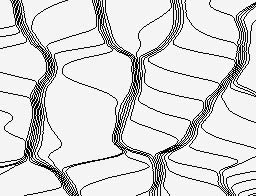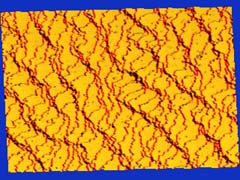Electromigration
When a silicon sample is heated with a direct electric current, significant changes in surface morphology can take place. The adatoms acquire an effective charge and undergo driven diffusion in response to the field. We try to to model this electromigration effect on Si(111) surfaces using a step model and also using a solid-on-solid (SOS) model.

Step Model
When the electric current is perpendicular to the step edges, step bunching can occur, where the surface separates into regions of high step density and flat facets. We simulate this step bunching process by numerically integrating a set of partial differential equations using a step model. Click to view a quicktime (994K) or a MPEG (1000K) movie. Click here for more information.
Solid-on-Solid Model
When there is an external driving force acting on surface atoms in a direction parallel to the step edge direction, there is a step-bending instability that produces novel step patterns. Click to view a quicktime (1110K) or a MPEG (1110K) movie of a simulation.
Return